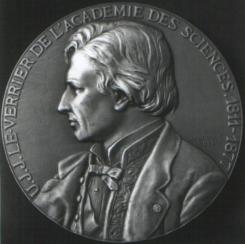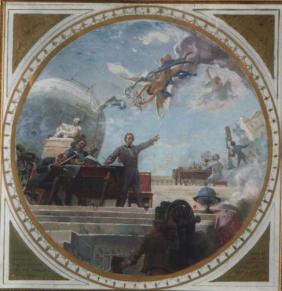
|
ANNOUNCING
THE DISCOVERY
This second letter of Glaisher’s was identical
with the first public announcement by the Reverend James Challis,
writing to The Cambridge Chronicle on October 1st. He announced
that Adams and Leverrier had both arrived at their similar conclusions
‘four months’ earlier in June, having both ‘agreed
on fixing on 325 degrees of heliocentric longitude as the most probable
position, which has proved to be very little different from the
actual’. He had been searching for the past two months in
this space, he explained. This newspaper was published in Cambridge
on the 3rd, so either a copy was rushed to Greenwich that day, or
Glaisher met Challis to discuss the matter. In June, Leverrier had published his first prediction,
using a circular orbit, citing 325 degrees as his prediction. Then
in July Adams constructed a guide for Challis to use for his sky-search,
which essentially took that position, at the epoch specified by
Leverrier, and converted it into RA and Dec co-ordinates for telescope
use (see "Adams’ July Ephemeris").
This was the document which Challis brandished at the November 13th
RAS meeting, emphasizing how useful it had been to him. It gave
the movement, through the months, of the Bode-law orbit body, in
circular orbit, as Leverrier had explained. (Challis managed to
convey the impression that this document was based upon the perturbation-computations
which Adams had been performing the year before). It is thus fairly
clear, that both Challis at Cambridge and Glaisher at Greenwich
were going public with a story based upon these events around June-July.
Adams’ July ephemeris had advocated 325 of helio longitude
for the beginning of September. Clearly, Challis had this in front
of him when he wrote. On October 5th, Challis wrote a letter to Arago,
which Arago at once published in Comptes Rendues, praising Leverrier’s
achievement, and claiming to have followed his guidance ‘Je
me conformai strictement aux suggestions de cet astronome’
(Oct 12th issue, p.715) and making no mention of Adams. After that, Challis changed his mind. Carelessly,
he explained to the Cambridge Chronicle two weeks later (Oct 17th),
he had written his last letter ‘without consulting memoranda,’
and then came out with the now-familiar story. If he ever did possess
any such ‘memoranda’ he didn’t keep them. If he
had been given predicted elements from Adams the previous September,
they were not then remembered (see Challis’
Unseen Testimony). The person doing the sky-search here appears
rather vague about why he was doing it, or where he was supposed
to be looking.
Post-Discovery Reticence It was not until seven weeks after D-day (Neptune’s
discovery) that the world could be told what Adams’ predictions
were supposed to have been. No wonder that Francois Arago described
Adams’ work as ‘clandestine.’ At a stormy meeting
of the Paris Academy of Sciences on October 19th, Arago fulminated
at how ‘Mr Challis so exaggerates the merit of Mr Adams’s
clandestine work, that he assigns to the young Cambridge geometer
the right to name the new heavenly body’ (Challis and Adams
had come up with the name ‘Oceanus’ and proposed in
to The Athenaeum,Oct 17th - Arago had received that paper fairly
quickly). He described Adams as a ‘young man who has communicated
nothing to the public.’
LeVerrier pictures by permission of the Observatoire de Paris Archives |

 Astronomer
John Hind’s letter appeared in The Times of October 1st, announcing
the new planet’s discovery. Airy being out of the country,
it fell to James Glaisher a senior RGO worker to write an announcement,
and he wrote to The Illustrated London News on October 1st. His
letter simply said that Leverrier’s prediction had been confirmed
by Dr Galle, in Berlin. Two days later, he wrote another letter.
He may have been in touch with Challis, because this letter described
the latter’s prolonged sky-search and even the ‘seems
to have a disc’ remark which Challis averred he had inscribed
adjacent to Neptune. This second letter explained that ‘about
four months ago’ both Adams and Leverrier had: ‘concluded,
independently, from theoretical calculations’ the position
of a perturbing planet. These two mathematicians, Glaisher added,
‘agreed in fixing 325 deg. of heliocentric longitude as the
most probable position of the perturbing planet ..., ’ which
position was ‘very nearly’ true.
Astronomer
John Hind’s letter appeared in The Times of October 1st, announcing
the new planet’s discovery. Airy being out of the country,
it fell to James Glaisher a senior RGO worker to write an announcement,
and he wrote to The Illustrated London News on October 1st. His
letter simply said that Leverrier’s prediction had been confirmed
by Dr Galle, in Berlin. Two days later, he wrote another letter.
He may have been in touch with Challis, because this letter described
the latter’s prolonged sky-search and even the ‘seems
to have a disc’ remark which Challis averred he had inscribed
adjacent to Neptune. This second letter explained that ‘about
four months ago’ both Adams and Leverrier had: ‘concluded,
independently, from theoretical calculations’ the position
of a perturbing planet. These two mathematicians, Glaisher added,
‘agreed in fixing 325 deg. of heliocentric longitude as the
most probable position of the perturbing planet ..., ’ which
position was ‘very nearly’ true. 